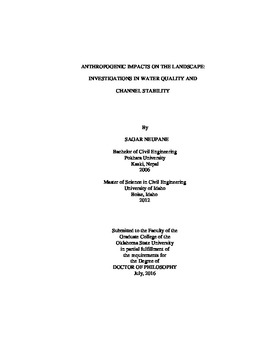| dc.contributor.advisor | Vogel, Jason R. | |
| dc.contributor.author | Neupane, Sagar | |
| dc.date.accessioned | 2018-06-25T13:38:26Z | |
| dc.date.available | 2018-06-25T13:38:26Z | |
| dc.date.issued | 2016-07 | |
| dc.identifier.uri | https://hdl.handle.net/11244/300256 | |
| dc.description.abstract | The natural landscape has been impacted by human settlement, development and agricultural practices. One of the major impacts of these anthropogenic activities is excessive upland soil erosion. During runoff events, eroded soil, or sediment, is transported to surface-water bodies and may impair water quality. To evaluate water-quality impairments, turbidity, suspended sediment, color and dissolved organic carbon have been commonly monitored in surface waters. In this study, water-quality and channel-stability parameters were evaluated in three parts. The objective of the first part was to develop a turbidity prediction methodology which can be integrated into existing runoff-erosion models. Based on the soil primary-particle sizes (sand, silt and clay), a turbidity prediction methodology was developed and applied to selected soils from Oklahoma and South Carolina. The methodology can be an add-on tool to runoff-erosion models to predict turbidity. The objective of the second part was to predict the water color of water samples with heterogeneous organic sources. Results showed a high correlation (R2 = 0.99 and Nash-Sutcliffe efficiency = 0.95) between predicted and measured color for multiple sources in a laboratory study. The results of this study could be useful to predict water color in runoff from field-scale watersheds. The objective for the third part was to develop and apply an integrated approach to evaluate channel planform stability in an agricultural watershed with limited field data using historical records such as plat maps, aerial images, flow records, and relevant historical events. The approach has been applied in the Cobb Creek watershed in west-central Oklahoma. The results of the third part showed the length of the stream-channel network increased between 1873 and 2013 in the watershed and also found a decreasing trend in channel lateral migrations and planform stability in the mainstem of Cobb Creek since 1940. Overall, the methodologies and findings presented in this dissertation are useful for modeling and assessing the impacts of anthropogenic activities on water quality in runoff and streams and can be useful tools in shaping future watershed-management decisions. | |
| dc.format | application/pdf | |
| dc.language | en_US | |
| dc.rights | Copyright is held by the author who has granted the Oklahoma State University Library the non-exclusive right to share this material in its institutional repository. Contact Digital Library Services at lib-dls@okstate.edu or 405-744-9161 for the permission policy on the use, reproduction or distribution of this material. | |
| dc.title | Anthropogenic impacts on the landscape: Investigations in water quality and channel stability | |
| dc.contributor.committeeMember | Storm, Daniel E. | |
| dc.contributor.committeeMember | Fox, Garey A. | |
| dc.contributor.committeeMember | Wilber, Gregory G. | |
| osu.filename | Neupane_okstate_0664D_14842.pdf | |
| osu.accesstype | Open Access | |
| dc.type.genre | Dissertation | |
| dc.type.material | Text | |
| thesis.degree.discipline | Biosystems and Agricultural Engineering | |
| thesis.degree.grantor | Oklahoma State University | |
